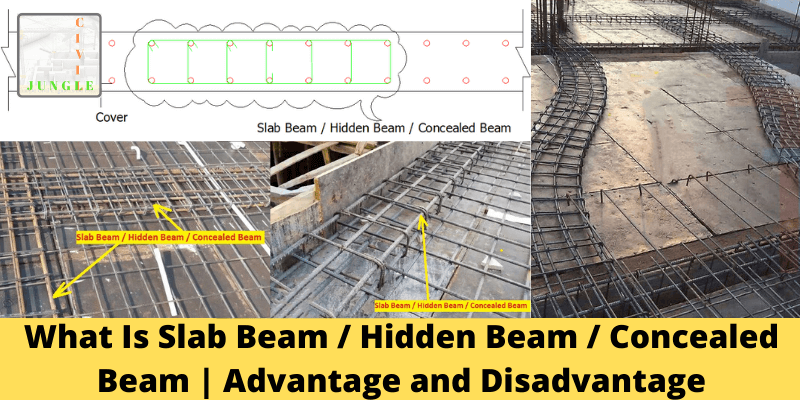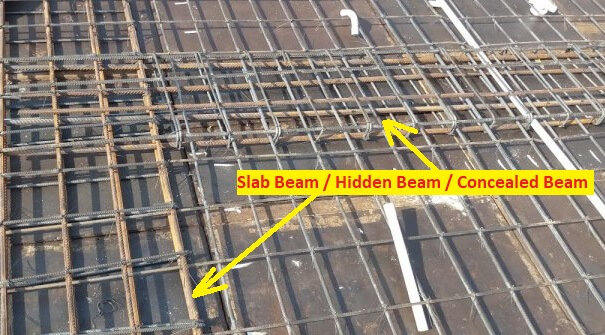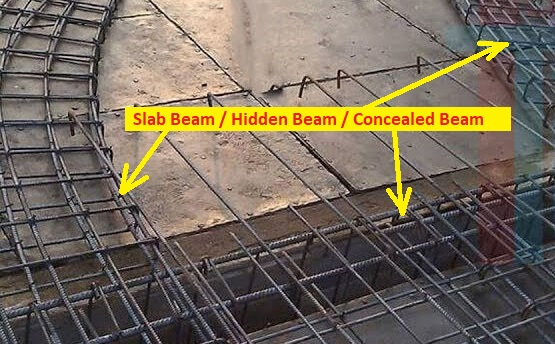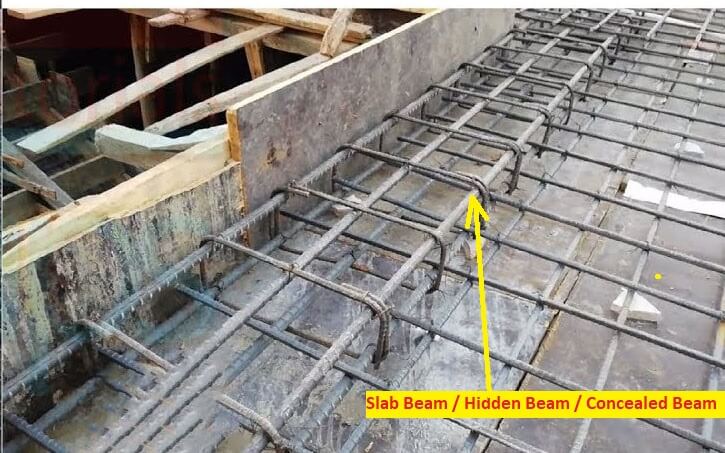What Is Slab Beam / Hidden Beam / Concealed Beam?
Important Point
The hidden beam is a reinforced concrete beam, also knows as a different name also like that, a Concealed Beam, and a Slab beam provided within the depth of supporting slabs.
So, the depth of the hidden beam is the same as slab depth, as may be noticed in as per below fig. Concealed beams are popular and form an essential part of modern reinforced concrete framed structures.
Lastly, strict and rigid architectural considerations led to the provision of hidden beams. In this manner, the load which could be brick wall will be dealt with, and the height of the floor won’t be compromised.
In this article, a different aspect of reinforced concrete hidden beams will be discussed.
Also, read: Why Hairline Cracks in Concrete | Type of Cracks in Concrete
Why It Is Used?
The concept of a Slab beam originated from a flat slab concept. Hidden Beams only means to spread the concentrated load of the walls on the slab area.
Where Did It Use in Buildings?
Hidden beams are usually inserted inside the suspended slabs where slab thickness is considerable.
The hidden beam is provided between dining and living spaces right angle to each other. This gives a neat and level ceiling surface that’s good for the look.
How to Design a Slab Beam / Hidden Beam / Concealed Beam?
The design of a hidden beam is the same as a conventional beam, but its depth is restricted and shouldn’t be greater slab thickness.
Therefore, it might be required to increase the reinforcement ration and width of the beam to overcome this restriction to a certain degree.
Also, read: 23 Different Types Cements Available in India and As Per IS Standards
Purpose of Slab Beam / Hidden Beam / Concealed Beam
Here, the different purposes of slab beams are as follows.
- It’s used to help disperse loads imposed on the slab for example weight of brickwork masonry wall.
- It allows using of a greater span for the slab.
- Hidden beams are provided exclusively for architectural aesthetic purposes in the building’s interior
- To break a wide panel of a slab into considerable size.
- Around the cutouts.
- To improve architectural aesthetic appearance by providing neat and leveled ceiling surface.
- To achieve maximum floor height.
- To clear the way for electromechanical duct work.
- It saves floor height clearance.
- It allows if brickwork needs to be constructed over the slab.
Advantages of Slab Beam / Hidden Beam / Concealed Beam
Slab Beam / Hidden Beam / Concealed Beam are desired structural element because of several advantages which include:
- By providing Hidden Beam floor height can achieved, clears the way for electromechanical duct-work, economical and also aesthetic appearance of the building.
- This is more applicable to commercial buildings.
- It’s economical as it saves the cost of materials, formwork, and labour.
Disadvantages of Slab Beam / Hidden Beam / Concealed Beam
Here, the disadvantages of concealed beam are as follows.
- The disadvantage of the hidden beam is that it’s considerably low ductility because of the height reinforcement ratio that’s provided to compensate for depth restriction specifically at column connection.
- Structurally it creates a spanning problem, as spans for structural support are in a right angle to each other. This means one slab structurally rests over the other.
Hidden Beam
Hidden beam is a reinforced concrete beam, also called concealed beam provided within the depth of supporting slabs. So, the depth of hidden beam is the same as slab depth as it can be noticed in Figure 2. Concealed beams are popular and form an essential part of modern reinforced concrete framed structures.
Flat Beam
Slab Beam
An RCC beam is provided within the slab, which depth is equal to the slab depth refers to the hidden beam. It also refers to a concealed beam. The hidden beam forms an integral part of the frame structure and is usually used.
Concealed Beam
Concealed beam is a reinforced concrete beam, also called concealed beam provided within the depth of supporting slabs. So, the depth of concealed beam is the same as slab depth as it can be noticed in the above figure. Concealed beams are popular and form an essential part of modern reinforced concrete framed structures.
Purpose of Slab Beam
Here, the different purposes of flat beams are as follows.
- It helps to break the extensive slab panel into considerable size.
- It helps to achieve the desired floor height.
- It allows brickwork over the slab.
- It helps to provide an easy path for ductwork.
Purpose of Hidden Beam
Here, the different purposes of hidden beams are as follows.
- To disperse loads on the supporting slab.
- To break a wide panel of slab to considerable size.
- Around the cutouts.
- To improve architectural aesthetic appearance by providing neat and leveled ceiling surface.
Purpose of Concealed Beam
Here, the different purposes of concealed beams are as follows.
- It is used to help disperse load imposed on the slab.
- It allows using a greater span of the slab.
- Concealed beam area is provided exclusively for the architectural aesthetic purposes in the building interior.
- To create a tying effect.
Advantages of Slab Beam
Here, the advantages of flat beam are as follows.
- By providing slab Beam floor height can achieved, clears the way for electromechanical duct-work, economical and also aesthetic appearance of the building.
- This is more applicable to commercial buildings.
Advantages of Hidden Beam
Here, the advantages of hidden beam are as follows.
- It saves on floor height clearance.
- Hidden beam saves cost of formwork, labor, and materials.
- It creates an acceptable aesthetic appearance which permits for efficient interior space partitioning.
- Concealed beam clears the way for horizontal electromechanical ductwork.
Advantages of Concealed Beam
Here, the advantages of concealed beam are as follows.
- Concealed beam is used to saves the cost of shuttering, form work, labors and construction materials.
- It gives clearance of storey height or floor to floor height.
- It creates an acceptable aesthetic appearance
- Concealed beam simplify the internal partition.
- Concealed beam provide a better appearance of interior structure.
Disadvantages of Slab Beam
Here, the disadvantages of flat beam are as follows.
- The disadvantage of the slab beam is that it’s considerably low ductility because of the height reinforcement ratio that’s provided to compensate for depth restriction specifically at column connection.
- Structurally it creates a spanning problem, as spans for structural support are in a right angle to each other. This means one slab structurally rests over the other.
Disadvantages of Hidden Beam
- Structurally it creates a spanning problem, as spans for structural support are at right angle to each other. This means one slab structurally rests over the other.
Disadvantages of Concealed Beam
- The disadvantage of Concealed beam is that it has considerably low ductility due to height reinforcement ratio which is provided to compensate for depth restriction specifically at column connection.
Like this post? Share it with your friends!
Suggested Read –
- Curing In Construction | Concrete Cure Time | Methods of curing
- Difference Between One Way Slab and Two Way Slab | What is Slab
- What Is Plaster | Plaster Ratio | History of Plastering | Requirements of Good Plaster
- What Is Construction Contract | Types of Engineering Contracts | Percentage-Rate Contract
- What Is Glass Fiber Reinforced Gypsum | Applications of GFRG | Disadvantages of The GFRG Panel
- What Is Structural Settlement | Causes For Structural Settlement | What Is Soil Settlement & Foundation Structural Settlement






The hidden beam is a reinforced concrete beam, also called concealed beam provided within the depth of supporting slabs.
So, the depth of the hidden beam is the same as slab depth as it can be noticed in the above figure.
Oncealed beams are popular and form an essential part of modern reinforced concrete framed structures.
Thanks for sharing
I am truly glad to read this blog posts which includes plenty of useful data, thanks for providing these statistics.
Thanks
Can i overlay a new slab of 4 inch thickness with 12mm bar reinforcement over a existing slab?
existing slab size 40*40 and is supported by 8inch beams and pillars?
Nice articale
Thanks
Hello
Can we have a complete concelead beam with 20mm rods for RCC slab . Considering I have one coloumn every 10 feet in a 30*20